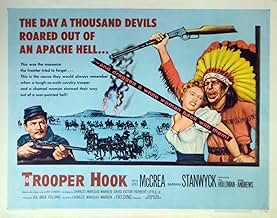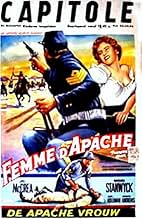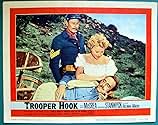अपनी भाषा में प्लॉट जोड़ेंWhen Apache chief Nanchez is captured by the cavalry, his white squaw and infant son are returned to civilization by Sergeant Hook, but Nanchez escapes custody and attempts to re-claim his s... सभी पढ़ेंWhen Apache chief Nanchez is captured by the cavalry, his white squaw and infant son are returned to civilization by Sergeant Hook, but Nanchez escapes custody and attempts to re-claim his son.When Apache chief Nanchez is captured by the cavalry, his white squaw and infant son are returned to civilization by Sergeant Hook, but Nanchez escapes custody and attempts to re-claim his son.
- Nanchez
- (as Rudolfo Acosta)
- Junius
- (as Cyril Delivanti)
फ़ीचर्ड समीक्षाएं
Upon capturing a band of marauding Apaches, Cavalry Sergeant Clovis Hook (McCrea) finds a white woman amongst the group. Cora Sutliff (Stanwyck) was taken by the Apache years ago and became the squaw of their leader, Nanchez (Acosta), she also bore him a child, Quito (Terry Lawrence). The army decides to reunite Cora with her white husband and charge Hook with delivering both her and Quito safely across country to the Sutliff homestead...
Splendid cast is assembled for this black and white Oater that is more about racism and the problems of inter-racial relations in the Old West, than it is a Cavalry Vs Indians shoot 'em up. Story essentially follows a stagecoach travelling across country that finds Hook, Cora and Quito encountering all manner of characters along the way, most of whom are racist. While of course there is the small matter of the Apache being on their tail as well.
Hook is a grizzled old badger, orders are orders, regardless of if he had any sort of objections to his mission, he's there to keep order and see the job through. For various reasons, everyone on the journey will be looking to him for action and decisions, not least Cora and Quito who begin to form a warm relationship with him. It of course builds to a head once the Apache come back onto the scene, and there's the issue of if Cora's husband will accept her and her half-breed son into his life?
It's very competently performed, and with the exception of some of the lower budget aspects of the production, it's well crafted by Warren. Unfortunately the writing doesn't always give the outside characters a quality of script befitting the themes of the story. Hook and Cora get some good back story, she in explanation of her captivity and he with his rueful recollections as a prisoner of the Civil War. While Holliman is served well as a genial cowpoke and Dano as the crotchety stagecoach driver is great fun.
Coming as it did post far better movies that dealt with prejudice themes in the Indian Wars, it feels like a coat tail grabber, and a watered down offering at that. That it's still a worthy viewing experience comes down to the work of a committed set of lead actors. 6.5/10
Those scenic Utah vistas, even in b&w, lend real credibility to the proceedings. And catch that opening scene. Note the brutality from both cavalry and Apaches, as latter execute prisoners, while former lays waste to Indian encampment. Throughout, the subtext hints at an underlying commonality between the two races despite the hostility. Or, as Apache Nanchez and cavalryman McCrea observe during a peace parley, there's a little of each in both of them.
Now, the question logically arises—given the warfare and brutality, why is McCrea so basically kind to enemy Stanwyck and son. Sure, she was captured and made a squaw and still has white skin, but she's also born Nanchez's son, captivity or no captivity. That's enough for most whites to hate her. Thanks to an intelligent script (except for the contrived ending), we find out. McCrea was a captive during the Civil War and stayed alive by imitating a dog, of all things. So, he knows what it's like to humiliate oneself in order to stay alive, which is what the unrepentant Stanwyck has done as a captive of the Apaches. It's a solid psychological point and a credit to McCrea that his character would risk such a demeaning episode in his background.
There's also the suspenseful stand-off around the fallen stagecoach. It's pretty clear that McCrea will shoot the boy if Nanchez attacks. It's also a pretty cold-blooded gamble. What's rather surprising is that McCrea shows no doubts or compunctions about risking the boy's life. Not too many Westerns of the time showed the hero holding a gun (through Holliman) to a little boy's head, amounting to an unusual departure, particularly for McCrea's apparent lack of feeling. Of course, what's going on underneath the steely resolve is likely entirely different.
Stanwyck is excellent as the stoical Cora Sutcliff. Her career had fallen off since there weren't many A-pictures available to a middle-aged star. But being the down-to-earth person she was known to be, she gives this B-Western her best, and it shows. I just wish Earl Holliman had more screen time. Some people are born to play certain parts, and he was born to play a good-natured, slightly oafish cowboy. His scenes with McCrea amount to little gems of unspoken affection. At the same time, I'm guessing young lady Kohner's part was added to Holliman's to give the movie more youth appeal. But most of all, the film has the great Joel McCrea. No actor brought more quiet dignity and less egotism to the traditional cowboy role than he. Unfortunately, I expect it's that very low-key approach that has lowered his public profile over the years. Too bad.
This 1957 release came at a time when both movies and TV were saturated with cowboys and six-guns. As a result, many quality Westerns got lost in the crowd, and, I expect, this humane little effort is one of them. Nonetheless, the ending is much too conventional and conveniently pat to distinguish the results completely from the pack. I just wish the script showed the same imagination in the last 5 minutes that it showed in the other 70-some. Then we would have had a complete little gem.
क्या आपको पता है
- ट्रिवियाThe last of six films co-starring Barbara Stanwyck and Joel McCrea as well as the only one in which McCrea gets top billing over Stanwyck. The previous are Gambling Lady (1934), Banjo on My Knee (1936) Internes Can't Take Money (1937), Union Pacific (1939) and The Great Man's Lady (1941).
- गूफ़Even though the story takes place some time soon after the Civil War, Barbara Stanwyck's hair style is strictly a 1957 perm.
- भाव
Ann Weaver: Adam, what would your feelings be if I were in her place?
Col. Adam Weaver: That doesn't even deserve an answer.
Ann Weaver: Doesn't it?
Col. Adam Weaver: You'd have killed yourself before you'd let it happen to you.
Ann Weaver: I wonder?
- कनेक्शनReferenced in Woman with a Whip (2018)
टॉप पसंद
- How long is Trooper Hook?Alexa द्वारा संचालित
विवरण
- चलने की अवधि1 घंटा 21 मिनट
- रंग
इस पेज में योगदान दें



































